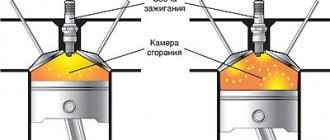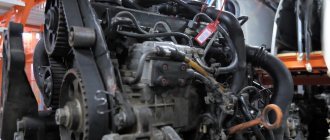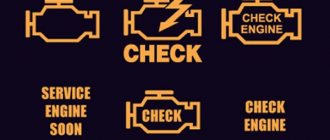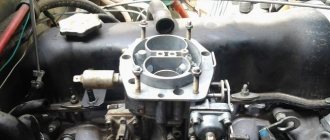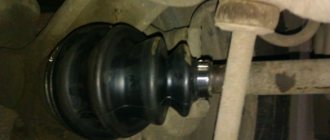Diesel engine features
A diesel engine is heavier and larger than a gasoline engine. The fundamental difference between internal combustion engines lies in the methods of formation of the combustible mixture, its ignition and combustion. Unlike a gasoline engine, in a diesel engine, fuel and air are supplied separately. Clean air enters the cylinders first. At the end of compression, when it is heated to a temperature of 700 - 800º C, fuel is injected into the combustion chamber of the nozzle under high pressure. Self-ignition occurs almost instantly. A feature of the diesel engine is high torque. Almost all internal combustion engines have glow plugs installed to heat the air in the combustion chamber at a low temperature.
Defrosters and additives, how they will help your car
To prevent diesel fuel from freezing, you should use special depressant additives - antigels, which reduce the gelation temperature and the filterability limit temperature, which makes it much easier to start a diesel engine at subzero temperatures. But, if the fuel is already frozen and anti-gels are not effective, it is necessary to use special diesel fuel defrosters designed to dissolve paraffin and ice crystals in frozen diesel fuel.
Main! Don't let diesel fuel turn into mush; use diesel fuel according to the season.
To defrost diesel fuel, many car owners add various products not intended for this purpose, such as kerosene, gasoline, alcohol and others. Of course, these are quite effective means in an emergency, but it is still better to use special defrosters and additives to avoid malfunctions in the future.
Many diesel owners, after a long night of parking, are faced with the fact that the car refuses to start, or the engine starts poorly - it vibrates and stalls. What are the reasons and what should be done to facilitate the cold start of a diesel engine?
Diesel engine stalls: reasons
A common problem with diesel engines is interruptions in the operation of the high pressure fuel pump. On cars older than 10 years, rubber hoses of fuel lines and connections may crack, which leads to air leaks from the injection pump. Other reasons why a running engine may stall after a short time are wear of plunger pairs and impurities in diesel fuel.
HBO for cars
A hot engine can also cause a breakdown in the case of an installed gas system. Since driving on gas has recently become profitable, many drivers switched to this type of fuel, however, they did not take into account some of the nuances of the new system. In hot weather, gas expands more, which leads to increased pressure inside the system and often causes damage. This is why it is bad to drive on gas in the heat.
At high temperatures, seals and hoses can fly off, which leads to gas leakage.
The result is an extremely dangerous situation. To avoid this, try not to fill the tank to full gas in the summer, this will reduce the pressure in the system and the risk of breakdown. If a similar problem occurs, it is recommended to let the car cool down and then visit a service station. You should not repair the gas system yourself; the equipment should be adjusted by a specialist.
Diesel engine does not start in summer
There may be several reasons, the main ones being:
- loss of diesel engine compression;
- clogging of the fuel system;
- problems with glow plugs.
Often the reason for the lack of necessary compression is wear of the cylinders, leaks in the combustion chamber, destruction of the compression piston rings, etc. In cases where there is no compression in one cylinder, the diesel engine can start, but after starting the engine is unstable, the diesel shakes violently. In a cylinder with insufficient compression, combustion of the working mixture can occur, but extremely irregularly.
If compression is low, a small amount of engine oil can be poured into the cylinders through the holes, after first unscrewing the glow plugs. Engine compression will temporarily increase. After the oil is squeezed out and burned out, the compression problem returns. The diesel engine may not start due to a clogged fuel system. If two spark plugs fail, it is almost impossible to start the engine.
Identifying and eliminating engine starting problems
UAZ does not start well when hot
In most cases, problems can be identified and fixed without much difficulty. So, a sign of clogged fuel filters will be difficulties starting the engine (it may stall at idle), a decrease in power, and also the car jerking during inclines.
It is worth noting that such “symptoms” can also be the result of other faults, such as wiring problems or faulty spark plugs. In this case, it is necessary to urgently replace the filters. If this is not done in time, the motor may fail.
Fuel supply can be checked by unscrewing the spark plugs. If they are filled with gasoline, or, on the contrary, are completely dry, then it is necessary to check the sensors or adjust the carburetor.
Another problem, a sign of which may be that the engine does not start when cold, is clogged injectors. In this case, the car loses dynamics when accelerating sharply, twitches and reacts poorly to pressing the gas pedal. In addition, muffled high-frequency noises may be heard coming from the cylinder block.
If the injectors are indeed coated with deposits, they need to be cleaned. You can do this yourself. There are several main ways to restore this part:
- The first cleaning method is rather preventive. It consists of adding special additives to the fuel that help get rid of deposits on the injector. However, many motorists try to use this method as little as possible: it is believed that additives can further worsen engine performance.
- Some experts recommend periodically turning the engine up to high speeds. After several kilometers at a speed of 100-110 km/h, engine performance should improve somewhat.
- If the injectors are seriously dirty, you will have to clean them manually. To do this, you need to disassemble the injector. After this, the parts are washed with high-quality fuel without impurities or kerosene and blown with compressed air.
- There are two more ways to clean injectors. They guarantee almost 100% results, but to implement them you need to use professional equipment and have certain skills. Therefore, it is better to contact a service center here. In the first case, the parts are exposed to ultrasound, which destroys all plaque. In the second, a special liquid and a device are used that is connected to the fuel receiver. After the engine has been idling for some time, the injector will be cleaned.
Important! You should not take action without making sure that a specific node is indeed the cause of the poor startup. This is especially true for complex work, the incorrect execution of which can lead to even more serious damage.
If in doubt, it is better to turn to professionals.
In conclusion, it is worth adding that it is better to look for the reasons for poor starting of a cold engine as they become more complex. So, you should not check the timing belt or engine compression without making sure there is fuel in the gas tank and a charge in the battery.
By methodically considering all possible fault options, you can get to the true cause of a poor start, and, in most cases, fix it yourself.
For this article are no comments yet. Be the first to comment.
Diesel engine does not start in winter
Diesel does not start when cold because summer diesel fuel thickens at sub-zero temperatures, turning into a waxy gel in the fuel system. The resulting paraffin crystals clog the diesel fuel filter. Heating the fuel system, replacing the fuel filter, or adding a special additive to the fuel can help start a diesel engine. Water entering a diesel engine can render the high pressure fuel pump unusable. Water in the tank appears when condensation forms in cold weather. Water and other impurities are retained in the coarse filter. If a diesel engine does not start in cold weather, the cause may be frozen water in the filter. To prevent water concentration in the fuel system, you can add a small amount of alcohol or a special additive - a dehydrator - to the tank. Air in the fuel line after inactivity leads to a drop in pressure. The most common damage and loss of elasticity of fuel hoses, rubber seals, rings, and seals occurs. Air is removed by pumping the injection pump and fuel line. At low temperatures, the frequently used 15W-40 engine oil becomes thick and can make starting a diesel engine difficult. Most problems with the starter and battery appear during the cold season. The diesel engine has a reinforced starter, since a high compression ratio of diesel fuel is required to start. At sub-zero temperatures, the battery noticeably loses its charge. A diesel engine starts poorly when cold, when a weak battery cannot crank the crankshaft at the required frequency to create pressure. With an undercharged battery and a faulty starter, it is almost impossible to start a diesel engine.
What needs to be done to ensure that the engine starts in any frost
Some actions taken in advance will allow you to start a working diesel engine in any frost without any problems.
- Change the battery to a battery with a larger capacity (from 75A, starting current from 780).
- Have an antigel additive in your car from a well-known manufacturer. Allows you to avoid the sedimentation of paraffin in fuel equipment.
- Install the fuel filter band heater. This measure allows you to start the engine on heated fuel. A “folk” method that replaces the heater - boiling water from a kettle onto the intake manifold, hoses, pipes and fuel filter. The effect is usually achieved, but using it on an expensive new car is barbaric.
- In winter, use oil with the lowest viscosity approved for use in a specific engine model.
Preparing a diesel engine for winter
- Before the cold weather sets in, recharge the battery.
- Before very severe frosts, you should remove the battery from the car and keep it in a warm, dry room.
- Keep the air filter clean.
- In winter, refuel only with good quality winter diesel fuel.
- Before using fuel additives, consult a specialist, and during use follow the recommendations and dosage.
- Systematically remove sediment from the fuel filter.
- Before the onset of the cold season, check the glow plugs, especially if they have been in service for more than two years.
- Install a pre-start heater if it is not included in the basic configuration.
- Flush the engine fuel system every two years
Why does a warm engine stall?
Some motorists are faced with a situation where an already running and warmed-up engine suddenly stalls. Moreover, this happens after the sensor has recorded a set of normal operating temperatures. There may be several reasons for this. Next, we will consider them in more detail, and also indicate what needs to be done in this or that case.
- Poor quality fuel. This situation is typical, for example, if you are driving away from a gas station, and after a short period of time the engine begins to “cough”, the car jerks and stalls. The solution here is obvious - drain the low-quality fuel, bleed the fuel system and replace the fuel filter. It is also advisable to replace the spark plugs, but if they are new, you can get by by blowing them out. Naturally, you shouldn’t go to such a gas station in the future, but if you have saved your receipt, you can go there and make a claim about the quality of the fuel.
- Fuel filter. If the engine stalls, you should also check the condition of the fuel filter. And if according to the regulations it is already necessary to replace it, then this must be done, regardless of whether it is clogged or not yet.
- Air filter. The situation is similar here. The engine may “choke” on the rich mixture and stall shortly after starting. Check its condition and replace if necessary. By the way, this way you can also reduce fuel consumption.
- Gasoline pump. If it does not operate at full capacity, the engine will not receive enough fuel and, accordingly, will stall after a while.
- Generator. If it completely or partially fails, it stops charging the battery. The driver may not immediately notice this fact, start the engine and drive away. However, it will only drive until the battery is completely discharged. Unfortunately, it will no longer be possible to start the engine on it again. In some cases, you can try to tighten the alternator belt. If this procedure does not help, you need to call a tow truck or call your friends to have your car dragged to a garage or service station.
Try to monitor the normal condition of the components and mechanisms listed above. Even minor breakdowns, if not corrected in time, can develop into big problems that will result in costly and complex repairs for you.
Conclusion
The first thing you need to do to ensure that the engine starts normally when hot is to refuel at proven gas stations, and also monitor the condition of your car’s fuel system. If, after even a short stay in the heat, the engine does not start, then first open the throttle valve (press the accelerator pedal) or remove the filter cover and leave it open for a couple of minutes. During this time, the evaporated gasoline will evaporate and you will be able to start the engine normally. If this procedure does not help, then it is necessary to troubleshoot among the components and mechanisms described above.
Hot engine failures
The reasons why a diesel engine does not start when hot are not as varied as those with carburetor power units. More than 70% of cases of difficult starting of a warm diesel engine occur due to problems in the fuel system, which consists of the following devices:
- air purifier;
- hand pump (this applies to old diesel engines);
- nozzles, sprayers;
- injection pump;
- fine filters, pre-cleaning of diesel fuel;
- crankshaft speed regulator;
- fuel drive.
In a constantly running diesel engine, the production of injectors, plungers, and sprayers occurs. Over time, springs lose their elasticity. Due to aging and exposure to high temperatures, rubber seals and sealing cuffs become less elastic, the density and tightness are impaired. Fuel lines become clogged due to poor quality fuel. This entails problems with the entire system.
Failure of factory regulation, uniform supply of precise volumes of mixture, advance angles, initial pressure of rising needles in injectors, and lowest crankshaft speeds at idle leads to an increase in diesel fuel consumption and constant smoke in exhaust gases. Often, difficult starting of a warm diesel engine occurs due to the following accompanying factors:
- low pressure in the fuel supply lines;
- The operation of the crankshaft position and air flow sensors is disrupted.
Diesel malfunctions visible from the outside and methods for eliminating them are shown in the table:
Oil too thick
As you know, diesel engines use a different lubricant than gasoline engines. However, this does not insure the car against difficult starts, especially in winter. As the temperature drops, the engine oil begins to thicken. Even with a charged battery, it will be difficult for the starter to turn the flywheel, and with it the crankshaft. Typically, diesel engines use motor oil with a viscosity of 15W-40.
When operating in extreme conditions, experts recommend lowering the bar to 5W-30. Thinner oil helps the crankshaft rotate more easily, which is especially important for an engine with lower temperatures.
Frozen fuel
This is another common reason why diesel is due to crystallization of the liquid. With each decrease in temperature, a paraffin deposit forms in the fuel. The fuel becomes cloudy and thick, similar to jelly.
But how are cars used in the northern regions? To avoid problems with starting, you need winter diesel fuel in cold weather. How is it different from the usual one? Unlike summer diesel fuel, winter diesel fuel contains additives that prevent the formation of paraffins and liquid crystallization. After all, thick fuel is not able to penetrate through the pores of the filter and the line, let alone the injectors.
Where can you buy winter diesel fuel? This fuel is sold at all gas stations during the cold season. Gas stations prepare in advance for the winter season by diluting the fuel with an “antigel” additive. It does not harm the engine - this has been tested by many car enthusiasts. However, some gas stations can sell leftover summer fuel already in winter. To avoid becoming a victim of circumstances, experienced motorists recommend carrying a bottle of anti-gel with you and adding it to the tank yourself.
Especially if a strong cold snap is expected. The proportions are indicated in the instructions. What is the freezing point of summer diesel fuel? Fuel is already waxed at -5 degrees Celsius. Therefore, always ask at gas stations whether it is Arctic fuel or not.
Why is it not diesel, but there are no other problems?
“The engine is not, but excellent, it works without any negative aspects in terms of fuel consumption and traction. I am in the USA, so everything is much more complicated with specialists. The dealership pumped out money, didn’t find the reason, they offered to change the injectors, I don’t understand why. I went to another service center, they suffered for a long time, thought and assumed that the problem was in the plunger pair, but they didn’t guarantee anything, they said that the computer gave an error for the injector of the fifth cylinder. They agreed that they would change the plunger pair, since all the symptoms pointed to it. But what if it doesn’t help? The service department said that the next step is the injectors, but I don’t think they need to be changed. Where then to move next? Freightliner M2-106″.
Depressurization of diesel injectors
Diesel injectors are also constantly subject to heavy loads, since during operation they are in an aggressive environment and in constant motion. Their purpose is dosed injection of fuel into the combustion chamber, and even slight wear leads to depressurization and loss of all characteristics. As a result, even after stopping the engine, a small amount of diesel continues to enter the combustion chamber, where it accumulates and interferes with the normal operation of the entire system.
The most common cause of injector depressurization is:
- Low quality fuel containing a large amount of undesirable impurities. This causes rapid damage to the atomizer.
- The assembly is of insufficient quality, which is why the injectors cannot withstand the pressure exerted on them.
- Various types of damage caused by improper functioning of other adjacent units.
To ensure that the injectors are depressurized, you must first remove the injector from the cylinder block and carefully inspect it for unusual wet spots. Getting the spark plugs wet is the surest sign of a leaky injector seal. To repair them, they require professional cleaning, which you can do yourself, or you can trust the professionals of automobile workshops. In some cases, it may be necessary to completely replace these elements.
If it is necessary to urgently start the engine, you can slightly open the throttle valve, which will relieve excess pressure in the combustion chamber. Additionally, it is recommended to check the sealing rings, since they are often the ones that begin to leak fuel due to wear.
Glow plugs
If the engine starts poorly in cold weather, especially in the cold in winter, but does not stall, the first thing you should do is check the glow plugs and the pre-heating system as a whole. Starting from +5, even a generally serviceable diesel engine with an inoperative air heating system in the combustion chamber will have difficulty starting. The system includes:
- glow plugs;
- heating relay;
- a bus that connects all spark plugs into a single circuit.
The check should begin with the glow plugs. I can assure you that the popular test method of measuring resistance with a multimeter is a largely ineffective test. It is designed to detect a rupture of the heating element (in this case there will be no resistance). All spark plugs may have resistance, but they will be the reason for poor starting in cold winter. At high temperatures outside or when the engine is hot, a serviceable diesel engine can be started without glow plugs at all.
In severe frost, the purpose of the pre-heating system is not only to facilitate starting, but also to help during the first seconds of warming up. After the “spiral” on the dashboard has died down, the spark plugs continue to work for some time. If you managed to start the internal combustion engine on a frosty morning, albeit off the air, but the engine continues to run unstably for some time, be sure to pay attention to diagnosing the glow plugs.
How to check
- The candle must be turned out of the well;
- connect it directly from the battery (ground to the spark plug body, plus to the bus connection point) and watch it warm up. A working candle necessarily glows from the edge, uniformly changing color as it heats up.
Only such a system will ensure proper starting in cold weather. Only the tip of the spark plug is in the combustion chamber. Therefore, a spark plug that shows resistance when tested may not be hot at the base and cause poor starting in winter.
All candles should heat up at approximately the same rate. If the engine does not start well after cooling, and after starting it smokes for a few seconds and runs unstably, you can safely start diagnostics with spark plugs.
It's also worth checking the relay. Perhaps due to oxidation of the contacts, it is not possible to transmit sufficient current for heating. Be aware of the possibility of a blown fuse or damaged tire. The warm-up time before starting depends on the coolant temperature. In extreme cases, the reasons for the incorrect operation of the system may be hidden in the corresponding sensor.
Domestic fuel at many gas stations is much better. Especially in cold weather, when waxing the fuel immobilizes diesel engines. For your own good, we will ask gas station employees to present a fuel quality certificate. If, after refueling at an untested gas station, the engine is difficult to start, it stalls, smokes or runs erratically - most likely there is a problem with the fuel. Only after checking it yourself can you be sure not only that the engine will start after an overnight stay and will not freeze when driving along the highway in severe frost.
Pressure, fuel portion and injection time
Part of the low-pressure circuit is the booster section in the injection pump housing (an analogue of a gasoline fuel pump in the tank can additionally be installed). A malfunction of the booster system will result in the starter being forced to build up pressure each time.
The cause of poor starting, the fact that the internal combustion engine stalls, may be the fuel injection pump regulator.
Incorrect OZ leads to uneven operation, poor starting, the engine smokes or even stalls in some operating ranges. Symptoms can appear both when hot and before reaching operating temperature.
The shamelessly “pouring” injectors add to the reasons for poor cold starting. Diagnostics:
- disconnect the return hoses. Instead, attach hoses of equal length, at the end of which attach ordinary syringes;
- start the internal combustion engine. Serviceable injectors should discharge an equal amount of fuel into the return line. If there is a significant scatter in the injectors, it is necessary to check on the stand and replace the faulty elements. Perhaps you'll get away with just sprays.
At the same time, when hot, the engine starts normally, does not stall, but smokes more than usual due to the over-enrichment of the mixture. On the cold side, smoke will come out of the exhaust pipe (fuel droplets that have not turned into “fog”, which therefore did not burn).

